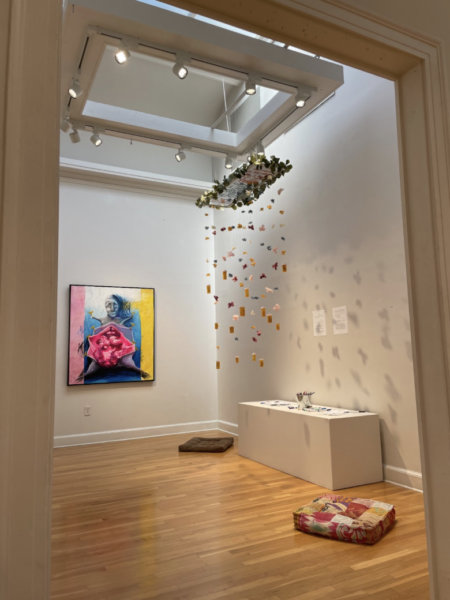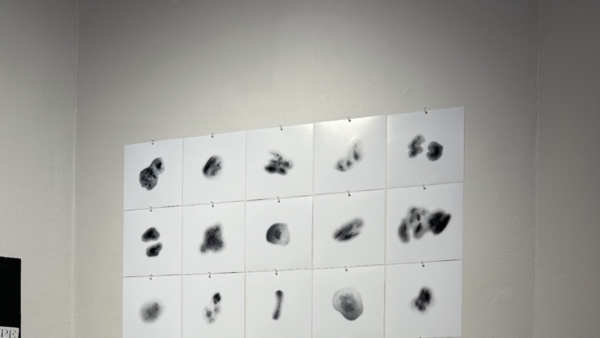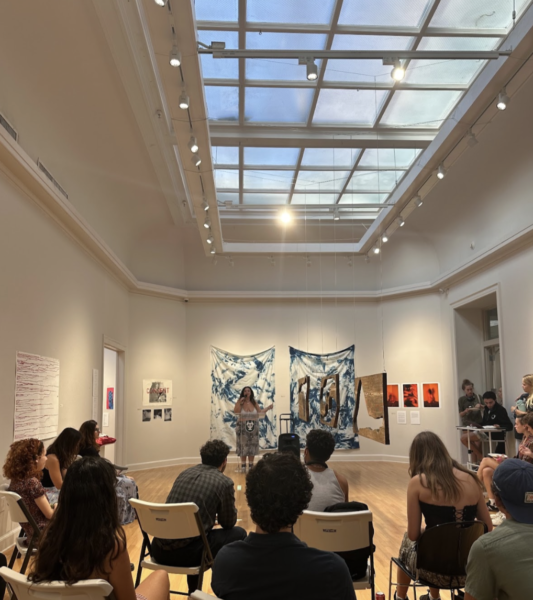Content warning: This article discusses general themes of sexual violence.

A diverse crowd composed of local artists, Tulane University students, sexual violence survivors and allies united on Thursday, Sept. 21 to celebrate Masked Violence Volume II, the newest exhibition at the Carroll Gallery in the Woldenberg Art Center.
Masked Violence Volume II is an art show that welcomes individuals from diverse backgrounds in the Tulane and greater New Orleans communities to create art or poems that center on sexual violence and emphasize survivor empowerment. However, the event’s opening was more than an art exhibition — it was a solemn night of recognition for victims and a celebration of strength.
The opening was so widely attended that chairs ran out 10 minutes before the slated start time. Tulane senior and event coordinator Sophi Tomasulo welcomed the audience and introduced staff from the Counseling Center and Sexual Aggression Peer Hotline and Education to speak about programming for sexual violence survivors. Following their announcements, the crowd listened intently as alumna Julia Hark performed her original poem “Hot Girl Ailments.” When she was done, she received thunderous applause.

When I asked Hark what being part of the exhibit meant to her, she said that she was thrilled Tomasulo opened the event to the wider community. “Your experience is still your experience,” Hark said, even after you leave campus.
By including alumni, the show highlighted that healing is not always total or linear, and that traumatic events can shape individuals for years to come.
For those participating in the exhibition, art offers a unique avenue to healing. “Putting it on paper or canvas … I feel like I can breathe again,” Hark said. This seemed to be a common theme of the night.
After the presentations, guests were invited to roam the three gallery rooms. The interactive piece that stuck out most to me was Leah Fradkin’s “Bottled Up.” Both heartbreaking and healing, the piece paid homage to not only her story, but the story of every survivor who has blamed themselves for their assault.
The piece consists of a downward-facing mirror on which Fradkin’s story is written; flowers and empty pill bottles adorn strings on the mirror and hang down towards the viewer. Viewers are invited to write their stories that they are not yet ready to share aloud and place them in the bottles for others to read and acknowledge. Fradkin said that her goal for this piece is for others to “heal and grow” by releasing their unspoken experiences.
I was impressed by the rawness and honesty showcased in the works of the contributing artists. No feelings are spared and no

emotions are censored. Masked Violence Volume II invites you to embrace the uncomfortable head-on, but not to stay there. By attaching names and visual elements to stories of assault, the gallery aims to mobilize viewers to demand a change in Tulane’s campus climate, one that has grown desensitized to instances of sexual abuse.
This desensitization is evident in the backlash in the days following the exhibition’s opening. Coordinator Tomasulo said that Masked Violence Volume II yard signs were destroyed and ripped down and a few people have made sexual innuendos in the guest book, making a mockery of the event as a whole. This shows that some Tulane students are lacking both awareness and compassion for survivors, which may be aided by viewing the gallery.
Tomasulo recognized a need for this event her freshman year. If the event continues next year, she would like to see more gender and racial diversity represented in the artwork, or “less white people and more men,” she said. This would allow the artists to be more representative of demographics that are disproportionately victimized by sexual assault or often go unnoticed. She said that she wants the exhibit to “hold the gravity” of stories that have become too commonplace on campus. Her ideal audience for the gallery transcends grade levels, majors and interest in art museums. Tomasulo suggested that guests “listen to other people’s stories the way you would like to be listened to … and empathize with them.”
I can guarantee that if you approach the exhibit with this mindset, you will leave as more informed and compassionate people.
As a Tulane student, the gallery was not easy to see. And that is exactly why you should go, while taking precautions to protect your mental well-being. Even those with little understanding of sexual violence culture stand to benefit from the exposure of the victim and survivor narratives that characterize the exhibit. Art is so valuable because it can break barriers and reach people who may not have been reached otherwise. In doing so, it can invite a diverse community to rally together to demand healing and justice.
The exhibit will be open in the Carroll Gallery of the Woldenberg Art Center until Oct. 20.



Leave a Comment